blender manual (PDF)
File information
This PDF 1.5 document has been generated by LaTeX with hyperref package / pdfTeX-1.40.14, and has been sent on pdf-archive.com on 02/02/2017 at 14:06, from IP address 91.183.x.x.
The current document download page has been viewed 16283 times.
File size: 75.79 MB (2030 pages).
Privacy: public file
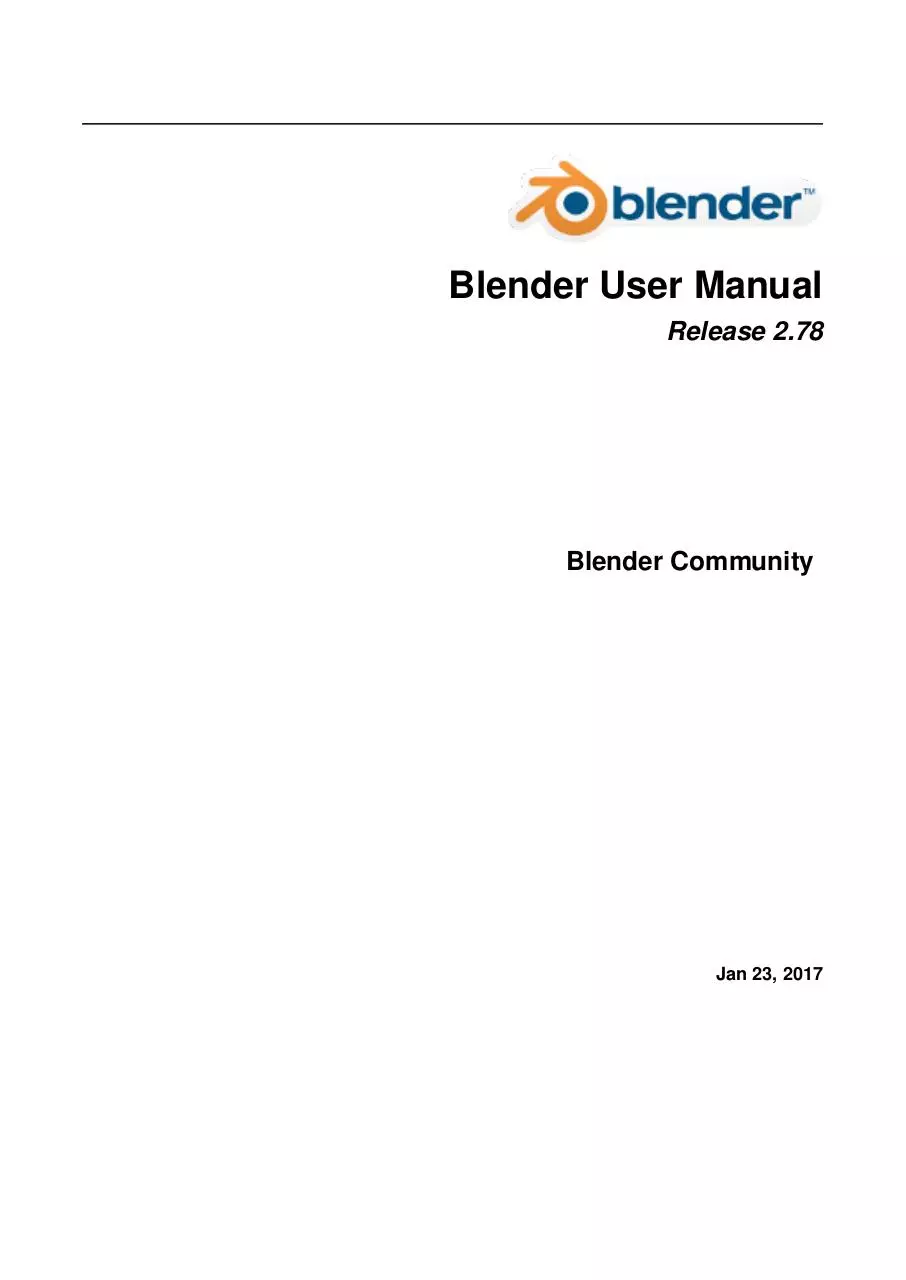
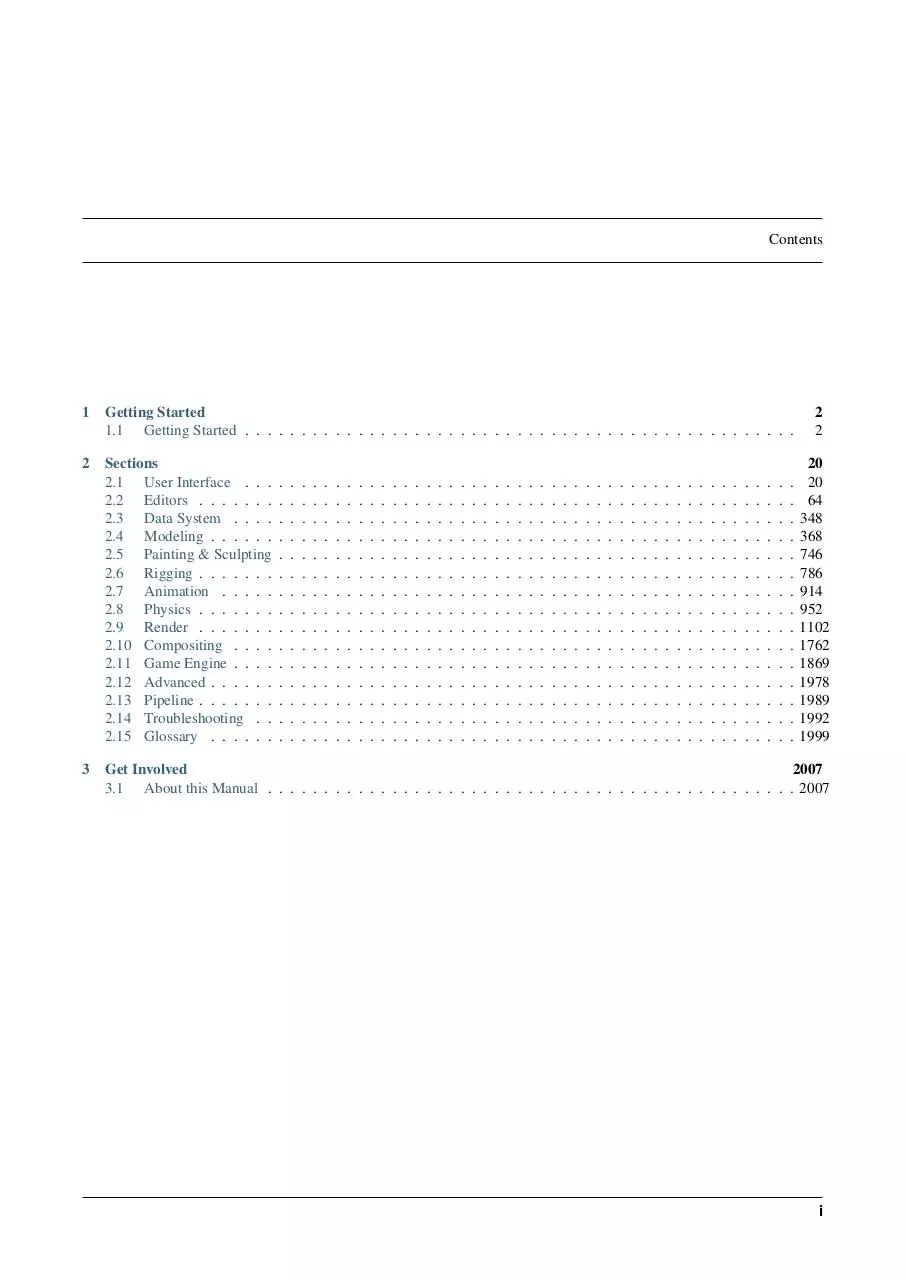
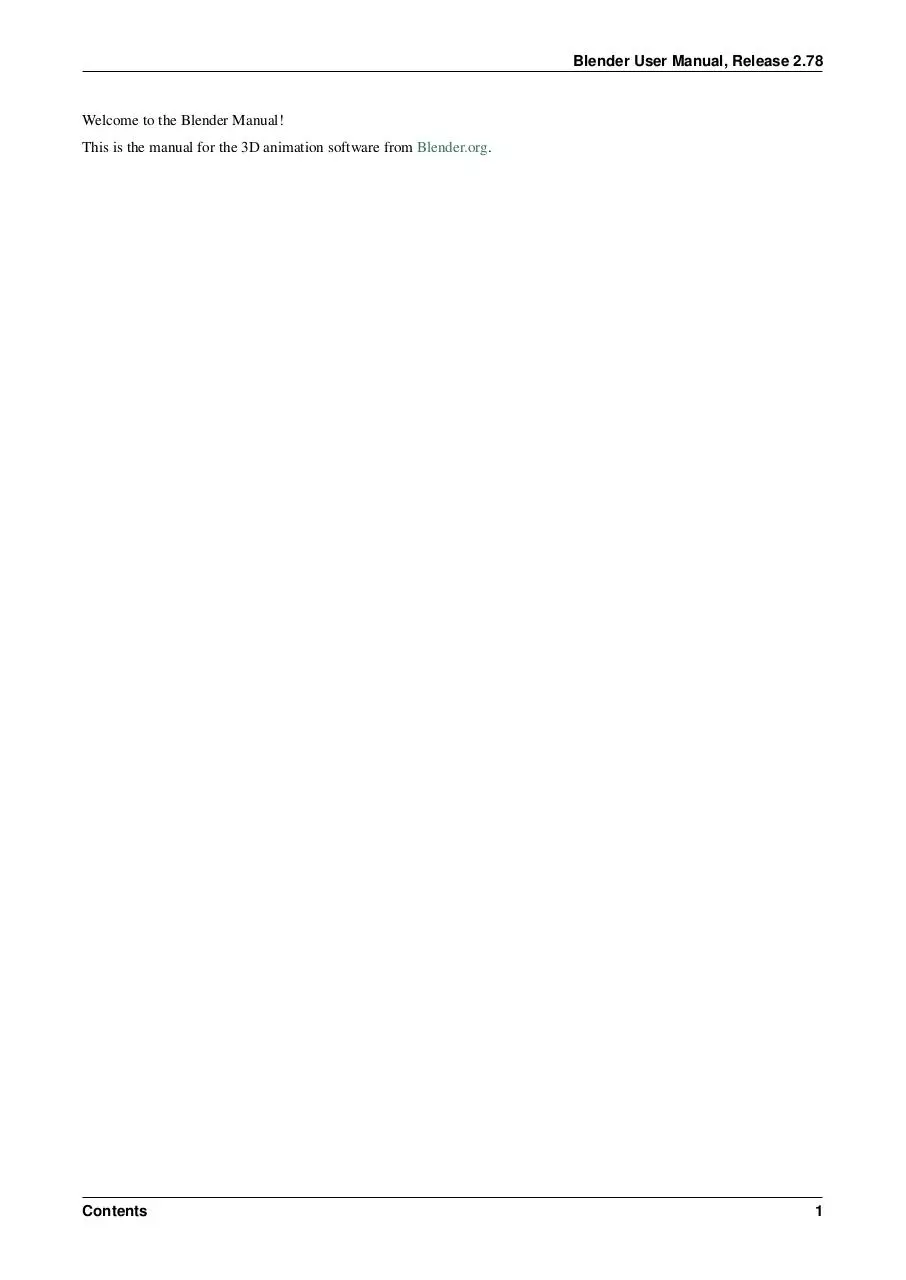
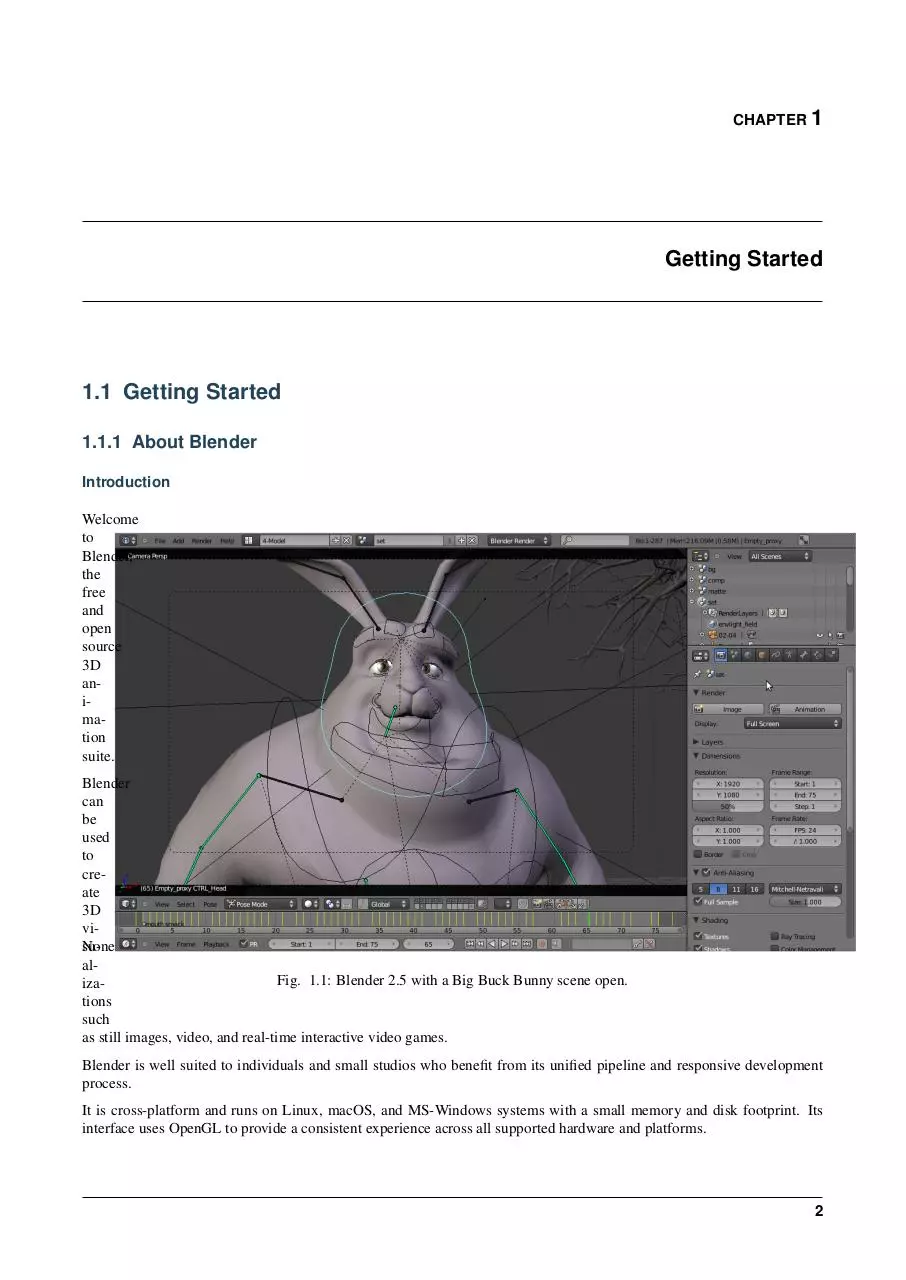

File preview
Blender User Manual
Release 2.78
Blender Community
Jan 23, 2017
Contents
1
Getting Started
1.1 Getting Started . . . . . . . . . . . . . . . . . . . . . . . . . . . . . . . . . . . . . . . . . . . . . . . . .
2
Sections
2.1 User Interface . . .
2.2 Editors . . . . . . .
2.3 Data System . . . .
2.4 Modeling . . . . . .
2.5 Painting & Sculpting
2.6 Rigging . . . . . . .
2.7 Animation . . . . .
2.8 Physics . . . . . . .
2.9 Render . . . . . . .
2.10 Compositing . . . .
2.11 Game Engine . . . .
2.12 Advanced . . . . . .
2.13 Pipeline . . . . . . .
2.14 Troubleshooting . .
2.15 Glossary . . . . . .
3
.
.
.
.
.
.
.
.
.
.
.
.
.
.
.
.
.
.
.
.
.
.
.
.
.
.
.
.
.
.
.
.
.
.
.
.
.
.
.
.
.
.
.
.
.
.
.
.
.
.
.
.
.
.
.
.
.
.
.
.
.
.
.
.
.
.
.
.
.
.
.
.
.
.
.
.
.
.
.
.
.
.
.
.
.
.
.
.
.
.
.
.
.
.
.
.
.
.
.
.
.
.
.
.
.
.
.
.
.
.
.
.
.
.
.
.
.
.
.
.
.
.
.
.
.
.
.
.
.
.
.
.
.
.
.
.
.
.
.
.
.
.
.
.
.
.
.
.
.
.
.
.
.
.
.
.
.
.
.
.
.
.
.
.
.
.
.
.
.
.
.
.
.
.
.
.
.
.
.
.
.
.
.
.
.
.
.
.
.
.
.
.
.
.
.
.
.
.
.
.
.
.
.
.
.
.
.
.
.
.
.
.
.
.
.
.
.
.
.
.
.
.
.
.
.
.
.
.
.
.
.
.
.
.
.
.
.
.
.
.
.
.
.
.
.
.
.
.
.
.
.
.
.
.
.
.
.
.
.
.
.
.
.
.
.
.
.
.
.
.
.
.
.
.
.
.
.
.
.
.
.
.
.
.
.
.
.
.
.
.
.
.
.
.
.
.
.
.
.
.
.
.
.
.
.
.
.
.
.
.
.
.
.
.
.
.
.
.
.
.
.
.
.
.
.
.
.
.
.
.
.
.
.
.
.
.
.
.
.
.
.
.
.
.
.
.
.
.
.
.
.
.
.
.
.
.
.
.
.
.
.
.
.
.
.
.
.
.
.
.
.
.
.
.
.
.
.
.
.
.
.
.
.
.
.
.
.
.
.
.
.
.
.
.
.
.
.
.
.
.
.
.
.
.
.
.
.
.
.
.
.
.
.
.
.
.
.
.
.
.
.
.
.
.
.
.
.
.
.
.
.
.
.
.
.
.
.
.
.
.
.
.
.
.
.
.
.
.
.
.
.
.
.
.
.
.
.
.
.
.
.
.
.
.
.
.
.
.
.
.
.
.
.
.
.
.
.
.
.
.
.
.
.
.
.
.
.
.
.
.
.
.
.
.
.
.
.
.
.
.
.
.
.
.
.
.
.
.
.
.
.
.
.
.
.
.
.
.
.
.
.
.
.
.
.
.
.
.
.
.
.
.
.
.
.
.
.
.
.
.
.
.
.
.
.
.
.
.
.
.
.
.
.
.
.
.
.
.
.
.
.
.
.
.
.
.
.
.
.
.
.
.
.
.
.
.
.
.
.
.
.
.
.
.
.
.
.
.
.
.
.
.
.
.
.
.
.
.
.
.
.
.
.
.
.
.
.
.
.
.
.
.
.
.
.
.
.
.
.
.
.
.
.
.
.
.
.
.
.
.
.
.
.
.
.
.
.
.
.
.
.
.
.
.
.
.
.
.
.
.
.
.
.
.
.
.
.
.
.
.
.
.
.
.
.
.
.
.
.
.
.
.
.
.
.
.
.
.
.
.
.
.
.
.
.
.
.
.
.
.
2
2
20
20
64
348
368
746
786
914
952
1102
1762
1869
1978
1989
1992
1999
Get Involved
2007
3.1 About this Manual . . . . . . . . . . . . . . . . . . . . . . . . . . . . . . . . . . . . . . . . . . . . . . . 2007
i
Blender User Manual, Release 2.78
Welcome to the Blender Manual!
This is the manual for the 3D animation software from Blender.org.
Contents
1
CHAPTER 1
Getting Started
1.1 Getting Started
1.1.1 About Blender
Introduction
Welcome
to
Blender,
the
free
and
open
source
3D
animation
suite.
Blender
can
be
used
to
create
3D
viNone
sualFig. 1.1: Blender 2.5 with a Big Buck Bunny scene open.
izations
such
as still images, video, and real-time interactive video games.
Blender is well suited to individuals and small studios who benefit from its unified pipeline and responsive development
process.
It is cross-platform and runs on Linux, macOS, and MS-Windows systems with a small memory and disk footprint. Its
interface uses OpenGL to provide a consistent experience across all supported hardware and platforms.
2
Blender User Manual, Release 2.78
Key Features
• Blender is a fully integrated 3D content creation suite, offering a broad range of essential tools, including Modeling,
Rendering, Animation, Video Editing, VFX, Compositing, Texturing, Rigging, many types of Simulations, and Game
Creation.
• Cross platform, with an OpenGL GUI that is uniform on all major platforms (and customizable with Python scripts).
• High-quality 3D architecture enabling fast and efficient creation work-flow.
• Excellent community support from forums and IRC.
• Small executable size, optionally portable.
You can download the latest version of Blender here.
Fig. 1.2: A rendered image being post-processed.
Blender makes it possible to perform a wide range of tasks, and it may seem daunting when first trying to grasp the basics.
However, with a bit of motivation and the right learning material, it is possible to familiarize yourself with Blender after a
few hours of practice.
This manual is a good start though it serves more as a reference. There are also many online video tutorials from specialized
websites, and several books and training DVDs available in the Blender Store and on the Blender Cloud.
Despite everything Blender can do, it remains a tool. Great artists do not create masterpieces by pressing buttons or
manipulating brushes, but by learning and practicing subjects such as human anatomy, composition, lighting, animation
principles, etc.
3D content creation software such as Blender have the added technical complexity and jargon associated with the underlying
technologies. Terms like UV maps, materials, shaders, meshes, and “subsurf” are the mediums of the digital artist, and
understanding them, even broadly, will help you to use Blender to its best.
So keep reading this manual, learn the great tool that Blender is, keep your mind open to other artistic and technological
areas and you too can become a great artist.
1.1. Getting Started
3
Blender User Manual, Release 2.78
Blender’s History
In 1988, Ton Roosendaal co-founded the Dutch animation studio NeoGeo. NeoGeo quickly became the largest 3D animation studio in the Netherlands and one of the leading animation houses in Europe. NeoGeo created award-winning
productions (European Corporate Video Awards 1993 and 1995) for large corporate clients such as multinational electronics company Philips. Within NeoGeo Ton was responsible for both art direction and internal software development. After
careful deliberation Ton decided that the current in-house 3D toolset for NeoGeo was too old and cumbersome to maintain,
and needed to be rewritten from scratch. In 1995 this rewrite began and was destined to become the 3D software creation
we all know as Blender. As NeoGeo continued to refine and improve Blender it became apparent to Ton that Blender could
be used as a tool for other artists outside of NeoGeo.
In 1998, Ton decided to found a new company called Not a Number (NaN) as a spin-off of NeoGeo to further market and
develop Blender. At the core of NaN was a desire to create and distribute a compact, cross-platform 3D application for free.
At the time, this was a revolutionary concept as most commercial 3D applications cost thousands of dollars. NaN hoped to
bring professional level 3D modeling and animation tools within the reach of the general computing public. NaN’s business
model involved providing commercial products and services around Blender. In 1999 NaN attended its first SIGGRAPH
conference in an effort to more widely promote Blender. Blender’s first SIGGRAPH convention was a huge success and
gathered a tremendous amount of interest from both the press and attendees. Blender was a hit and its huge potential
confirmed!
Following the success of the SIGGRAPH conference in early 2000, NaN secured financing of C4.5M from venture capitalists. This large inflow of cash enabled NaN to rapidly expand its operations. Soon NaN boasted as many as fifty employees
working around the world trying to improve and promote Blender. In the summer of 2000, Blender 2.0 was released. This
version of Blender added the integration of a game engine to the 3D application. By the end of 2000, the number of users
registered on the NaN website surpassed 250,000.
Unfortunately, NaN’s ambitions and opportunities did not match the company’s capabilities and the market realities of the
time. This over-extension resulted in restarting NaN with new investor funding and a smaller company in April 2001. Six
months later NaN’s first commercial software product, Blender Publisher was launched. This product was targeted at the
emerging market of interactive web-based 3D media. Due to disappointing sales and the ongoing difficult economic climate,
the new investors decided to shut down all NaN operations. The shutdown also included discontinuing the development
of Blender. Although there were clearly shortcomings in the then current version of Blender, such as a complex internal
software architecture, unfinished features and a non-standard way of providing the GUI, the enthusiastic support from the
user community and customers who had purchased Blender Publisher in the past meant that Ton could not justify leaving
Blender to fade into insignificance. Since restarting a company with a sufficiently large team of developers was not feasible,
Ton Roosendaal founded the non-profit organization Blender Foundation in March 2002.
The Blender Foundation’s primary goal was to find a way to continue developing and promoting Blender as a communitybased open source project. In July 2002, Ton managed to get the NaN investors to agree to a unique Blender Foundation plan
to attempt to release Blender as open source. The “Free Blender” campaign sought to raise C100,000 so that the Foundation
could buy the rights to the Blender source code and intellectual property rights from the NaN investors and subsequently
release Blender to the open source community. With an enthusiastic group of volunteers, among them several ex-NaN
employees, a fundraising campaign was launched to “Free Blender”. To everyone’s surprise and delight the campaign
reached the C100,000 goal in only seven short weeks. On Sunday, October 13, 2002, Blender was released to the world
under the terms of the GNU GPL. Blender development continues to this day driven by a team of dedicated volunteers from
around the world led by Blender’s original creator, Ton Roosendaal.
Version/Revision Milestones
The start!
• 1.00 – January 1994: Blender in development at animation studio NeoGeo.
• 1.23 – January 1998: SGI version published on the web, IrisGL.
• 1.30 – April 1998: Linux and FreeBSD version, port to OpenGL and X11.
• 1.3x – June 1998: NaN founded.
• 1.4x – September 1998: Sun and Linux Alpha version released.
1.1. Getting Started
4
Blender User Manual, Release 2.78
• 1.50 – November 1998: First Manual published.
• 1.60 – April 1999: C-key (new features behind a lock, $95), MS-Windows version released.
• 1.6x – June 1999: BeOS and PPC version released.
• 1.80 – June 2000: End of C-key, Blender full freeware again.
• 2.00 – August 2000: Interactive 3D and real-time engine.
• 2.10 – December 2000: New engine, physics, and Python.
• 2.20 – August 2001: Character animation system.
• 2.21 – October 2001: Blender Publisher launch.
• 2.2x – December 2001: macOS version.
Blender goes Open Source
• 13 October 2002: Blender goes Open Source, 1st Blender Conference.
• 2.25 – October 2002: Blender Publisher becomes freely available, and the experimental tree of Blender is created, a
coder’s playground.
• 2.26 – February 2003: The first truly open source Blender release.
• 2.27 – May 2003: The second open source Blender release.
• 2.28x – July 2003: First of the 2.28x series.
• 2.30 – October 2003: Preview release of the 2.3x UI makeover presented at the 2nd Blender Conference.
• 2.31 – December 2003: Upgrade to stable 2.3x UI project.
• 2.32 – January 2004: A major overhaul of internal rendering capabilities.
• 2.33 – April 2004: Game Engine returns, ambient occlusion, new procedural textures.
• 2.34 – August 2004: Particle interactions, LSCM UV mapping, functional YafRay integration, weighted creases in
subdivision surfaces, ramp shaders, full OSA, and many many more.
• 2.35 – November 2004: Another version full of improvements: object hooks, curve deforms and curve tapers, particle
duplicators and much more.
• 2.36 – December 2004: A stabilization version, much work behind the scene, normal and displacement mapping
improvements.
• 2.37 – June 2005: Transformation tools and widgets, softbodies, force fields, deflections, incremental subdivision
surfaces, transparent shadows, and multi-threaded rendering.
• 2.40 – December 2005: Full rework of armature system, shape keys, fur with particles, fluids, and rigid bodies.
• 2.41 – January 2006: Lots of fixes, and some Game Engine features.
• 2.42 – July 2006: The nodes release, array modifier, vector blur, new physics engine, rendering, lip sync, and many
other features. This was the release following Project Orange.
• 2.43 – February 2007: Multi-resolution meshes, multi-layer UV textures, multi-layer images and multi-pass rendering and baking, sculpting, retopology, multiple additional mattes, distort and filter nodes, modeling and animation
improvements, better painting with multiple brushes, fluid particles, proxy objects, sequencer rewrite, and postproduction UV texturing.
• 2.44 – May 2007: The big news, in addition to two new modifiers and re-awakening the 64-bit OS support, was the
addition of subsurface scattering, which simulates light scattering beneath the surface of organic and soft objects.
• 2.45 – September 2007: Serious bug fixes, with some performance issues addressed.
1.1. Getting Started
5
Blender User Manual, Release 2.78
• 2.46 – May 2008: The Peach release was the result of a huge effort of over 70 developers providing enhancements to
provide hair and fur, a new particle system, enhanced image browsing, cloth, a seamless and non-intrusive physics
cache, rendering improvements in reflections, AO, and render baking, a mesh deform modifier for muscles and such,
better animation support via armature tools and drawing, skinning, constraints and a colorful Action Editor, and
much more. It was the release following Project Peach.
• 2.47 – August 2008: Bugfix release.
• 2.48 – October 2008: The Apricot release, cool GLSL shaders, lights and GE improvements, snap, sky simulator,
shrinkwrap modifier, and Python editing improvements. This was the release following Project Apricot.
• 2.49 – June 2009: Node-based textures, armature sketching (called Etch-a-Ton), boolean mesh operation improvements, JPEG2000 support, projection painting for direct transfer of images to models, and a significant Python script
catalog. GE enhancements included video textures, where you can play movies in-game, upgrades to the Bullet
physics engine, dome (fish-eye) rendering, and more API GE calls made available.
Blender 2.5x – The Recode!
2.5x – From 2009 to August 2011: This series released four pre-version (from Alpha 0 in November 2009 to Beta in
July 2010) and three stable versions (from 2.57 - April 2011 to 2.59 - August 2011). It is one of the most important
development projects, with a total refactor of the software with new functions, redesign of the internal window manager
and event/tool/data handling system, and new Python API. The final version of this project was Blender 2.59 in August
2011.
Video: From Blender 1.60 to 2.50
Blender 2.6x to 2.7x – Improvements & Stabilizing
• 2.60 – October 2011: Internationalization of the UI, improvements in animation system and the GE, vertex weight
groups modifiers, 3D audio and video, and bug fixes.
• 2.61 – December 2011: The Cycles renderer was added in trunk, the camera tracker was added, dynamic paint
for modifying textures with mesh contact/approximation, the Ocean Sim modifier to simulate ocean and foam, new
add-ons, bug fixes, and more extensions added for the Python API.
• 2.62 – February 2012: The Carve library was added to improve boolean operations, support for object tracking was
added, the Remesh modifier was added, many improvements in the GE, matrices and vectors in the Python API were
improved, new add-ons, and many bug fixes.
• 2.63 – April 2012: Bmesh was merged to trunk with full support for n-sided polygons, sculpt hiding, a panoramic
camera for Cycles, mirror ball environment textures and float precision textures, render layer mask layers, ambient
occlusion and viewport display of background images and render layers, new import and export add-ons were added,
and 150 bug fixes.
• 2.64 – October 2012: Mask editor, improved motion tracker, OpenColorIO, Cycles improvements, sequencer improvements, better mesh tools (Inset and Bevel were improved), new keying nodes, sculpt masking, Collada improvements, new skin modifier, new compositing nodes backend, and many bugs were fixed.
• 2.65 – December 2012: Fire and smoke improvements, anisotropic shader for Cycles, modifier improvements, bevel
tool now includes rounding, new add-ons, and over 200 bug fixes.
• 2.66 – February 2013: Dynamic topology, rigid body simulation, improvements in UI and usability (including retina
display support), Cycles now supports hair, the bevel tool now supports individual vertex beveling, new Mesh Cache
modifier and the new UV Warp modifier, new SPH particle fluid solver. More than 250 bug fixes.
• 2.67 – May 2013: Freestyle was added, paint system improvements, subsurface scattering for Cycles, Ceres library
in the motion tracker, new custom Python nodes, new mesh modeling tools, better support for UTF-8 text and
improvements in text editors, new add-ons for 3D printing, over 260 bug fixes.
1.1. Getting Started
6
Blender User Manual, Release 2.78
• 2.68 – July 2013: New and improved modeling tools, three new Cycles nodes, big improvements in the motion
tracker, Python scripts and drivers are disabled by default when loading files for security reasons, and over 280 bug
fixes.
• 2.69 – October 2013: Even more modeling tools, Cycles improved in many areas, plane tracking is added to the
motion tracker, better support for FBX import/export, and over 270 bugs fixed.
• 2.70 – March 2014: Cycles gets basic volumetric support on the CPU, more improvements to the motion tracker, two
new modeling modifiers, some UI consistency improvements, and more than 560 bug fixes.
• 2.71 – June 2014: Deformation motion blur and fire/smoke support is added to Cycles, UI pop-ups are now draggable,
performance optimizations for sculpting mode, new interpolation types for animation, many improvements to the GE,
and over 400 bug fixes.
• 2.72 – October 2014: Cycles gets volume and SSS support on the GPU, pie menus are added and tooltips greatly
improved, the intersection modeling tool is added, new sun beam node for the compositor, Freestyle now works with
Cycles, texture painting workflow is improved, and more than 220 bug fixes.
• 2.73 – January 2015: Cycles gets improved volumetric support, major upgrade to grease pencil, MS-Windows gets
Input Method Editors (IMEs) and general improvements to painting, freestyle, sequencer and add-ons.
• 2.74 – March 2015: Support for custom-normals, viewport compositing and improvements to hair dynamics.
• 2.75 – July 2015: Integrated stereo/multi-view pipeline, corrective smooth modifier and new dependency graph
(enable as a command line option).
• 2.76 – November 2015: Pixar OpenSubdiv support, Viewport and File Browser performance boost, node auto-offset,
and a text effect strip for the Sequencer.
• 2.77 – March 2016: OpenVDB support for caching for smoke/volumetric simulations, improved cycles Subsurface
Scattering, Grease pencil stroke sculpting and improved workflow, and reworked library handling to manage missing
and deleted data-blocks.
• 2.78 – September 2016: Cycles support for spherical stereo images for VR, Grease Pencil works more similar to
other 2D drawing softwares, Alembic import and export support, and improvements to Bendy Bones for easier
and simpler rigging.
About Free Software and the GPL
When one hears about “free software”, the first thing that comes to mind
might be “no cost”. While this is typically true, the term “free software”
as used by the Free Software Foundation (originators of the GNU Project
and creators of the GNU General Public License) is intended to mean “free
as in freedom” rather than the “no cost” sense (which is usually referred to
as “free as in free beer” or gratis). Free software in this sense is software
which you are free to use, copy, modify, redistribute, with no limit. Contrast
this with the licensing of most commercial software packages, where you
are allowed to load the software on a single computer, are allowed to make
no copies, and never see the source code. Free software allows incredible
freedom to the end user. Since the source code is universally available, there
are also many more chances for bugs to be caught and fixed.
When a program is licensed under the GNU General Public License (the
GPL):
• You have the right to use the program for any purpose.
• You have the right to modify the program and have access to the source
codes.
• You have the right to copy and distribute the program.
• You have the right to improve the program, and release your own versions.
1.1. Getting Started
7
Download blender-manual
blender-manual.pdf (PDF, 75.79 MB)
Download PDF
Share this file on social networks
Link to this page
Permanent link
Use the permanent link to the download page to share your document on Facebook, Twitter, LinkedIn, or directly with a contact by e-Mail, Messenger, Whatsapp, Line..
Short link
Use the short link to share your document on Twitter or by text message (SMS)
HTML Code
Copy the following HTML code to share your document on a Website or Blog
QR Code to this page
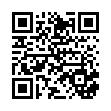
This file has been shared publicly by a user of PDF Archive.
Document ID: 0000548221.